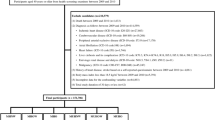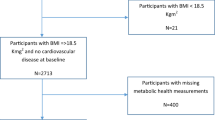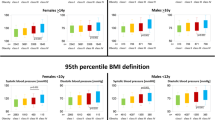Abstract
Background/Objectives:
The clinical relevance of the metabolically healthy overweight/obese (MHO) phenotype is controversial and the relationships between weight change and the development of cardiometabolic risk factors is unknown. Therefore, we aim to: (1) Assess the long-term risk of developing one or more components of the metabolic syndrome in MHO adults compared with metabolically healthy normal weight (MHNW); (2) Evaluate risk of a composite of death, cardiovascular disease (CVD), and risk of developing type 2 diabetes between adults defined according to baseline body mass index and metabolic health.
Subjects/Methods:
Retrospective cohort study of adults 18–65 years of age seen at our institution between 1998 and 2000 who lived in Olmsted County. Metabolically healthy was defined as the absence of all components of the metabolic syndrome (except for waist circumference). Main outcome was the development of metabolic risk factors. The secondary outcome was a composite of mortality, CVD and heart failure.
Results:
Of the 18 070 individuals with complete data at baseline, 1805 (10%) were MHO (mean age 38±11 years) and 3047 were MHNW (mean age 35±11 years). After a median follow-up of 15 years, interquartile range 10–17, 80% of MHO vs 68% of MHNW developed at least one cardiometabolic risk factor (P<0.001). In multivariate analysis, MHO individuals who gained ⩾10% of their body weight were more likely to have developed metabolic complications compared to MHO individuals that did not gain weight (P=0.001 for 10–15%, P<0.001 for >15% weight gain). The risk for the secondary composite end point was similar between MHO and MHNW, number of events 218/1805 vs 217/3048 for MHO and MHNW, respectively, (hazard ratio: 1.16, 95% confidence interval: 0.96–1.40).
Conclusions:
MHO are more likely to develop metabolic complications than MHNW, especially if they gain weight.
This is a preview of subscription content, access via your institution
Access options
Subscribe to this journal
Receive 12 print issues and online access
$259.00 per year
only $21.58 per issue
Buy this article
- Purchase on Springer Link
- Instant access to full article PDF
Prices may be subject to local taxes which are calculated during checkout



Similar content being viewed by others
References
Jensen MD, Ryan DH, Apovian CM, Ard JD, Comuzzi AG, Donato KA et al. 2013 AHA/ACC/TOS guideline for the management of overweight and obesity in adults: a report of the American College of Cardiology/American Heart Association Task Force on Practice Guidelines and The Obesity Society. Circulation 2014; 129: S102–S138.
Schroder H, Ramos R, Baena-Diez JM, Mendez MA, Canal DJ, Fito M et al. Determinants of the transition from a cardiometabolic normal to abnormal overweight/obese phenotype in a Spanish population. Eur J Nutr 2014; 53: 1345–1353.
Appleton SL, Seaborn CJ, Visvanathan R, Hill CL, Gill TK, Taylor AW et al. Diabetes and cardiovascular disease outcomes in the metabolically healthy obese phenotype: a cohort study. Diabetes Care 2013; 36: 2388–2394.
Hinnouho GM, Czernichow S, Dugravot A, Nabi H, Brunner EJ, Kivimaki M et al. Metabolically healthy obesity and the risk of cardiovascular disease and type 2 diabetes: the Whitehall II cohort study. Eur Heart J 2015; 36: 551–559.
Senechal M, Wicklow B, Wittmeier K, Hay J, MacIntosh AC, Eskicioglu P et al. Cardiorespiratory fitness and adiposity in metabolically healthy overweight and obese youth. Pediatrics 2013; 132: e85–e92.
Velho S, Paccaud F, Waeber G, Vollenweider P, Marques-Vidal P . Metabolically healthy obesity: different prevalences using different criteria. Eur J Clin Nutr 2010; 64: 1043–1051.
Kramer CK, Zinman B, Retnakaran R . Are metabolically healthy overweight and obesity benign conditions?: A systematic review and meta-analysis. Ann Intern Med 2013; 159: 758–769.
Morkedal B, Vatten LJ, Romundstad PR, Laugsand LE, Janszky I . Risk of myocardial infarction and heart failure among metabolically healthy but obese individuals: HUNT (Nord-Trondelag Health Study), Norway. J Am Coll Cardiol 2014; 63: 1071–1078.
Ogorodnikova AD, Kim M, McGinn AP, Muntner P, Khan U, Wildman RP . Incident cardiovascular disease events in metabolically benign obese individuals. Obesity 2012; 20: 651–659.
Zheng R, Zhou D, Zhu Y . The long-term prognosis of cardiovascular disease and all-cause mortality for metabolically healthy obesity: a systematic review and meta-analysis. J Epidemiol Community Health 2016; 70: 1024–1031.
Soriguer F, Gutierrez-Repiso C, Rubio-Martin E, Garcia-Fuentes E, Almaraz MC, Colomo N et al. Metabolically healthy but obese, a matter of time? Findings from the prospective Pizarra study. J Clin Endocrinol Metab 2013; 98: 2318–2325.
Al Suwaidi J . Is there an increased cardiovascular risk in metabolically healthy obese individuals? Lessons from the HUNT (Nord-Trondelag Health) study. Glob Cardiol Sci Pract 2014; 2014: 44–47.
Hamer M, Stamatakis E . Metabolically healthy obesity and risk of all-cause and cardiovascular disease mortality. J Clin Endocrinol Metab 2012; 97: 2482–2488.
World Health Organization. Obesity: preventing and managing the global epidemic. Report of a WHO consultation. World Health Organ Tech Rep Ser 2000; 894, i-xii 1–253, http://www.who.int/nutrition/publications/obesity/WHO_TRS_894/en/.
Alberti KG, Zimmet P, Shaw J . The metabolic syndrome—a new worldwide definition. Lancet 2005; 366: 1059–1062.
Birman-Deych E, Waterman AD, Yan Y, Nilasena DS, Radford MJ, Gage BF . Accuracy of ICD-9-CM codes for identifying cardiovascular and stroke risk factors. Med Care 2005; 43: 480–485.
Andrade SE, Harrold LR, Tjia J, Cutrona SL, Saczynski JS, Dodd KS et al. A systematic review of validated methods for identifying cerebrovascular accident or transient ischemic attack using administrative data. Pharmacoepidemiol Drug Saf 2012; 21 (Suppl 1): 100–128.
Mell MW, Pettinger M, Proulx-Burns L, Heckbert SR, Allison MA, Criqui MH et al. Evaluation of medicare claims data to ascertain peripheral vascular events in the Women's Health Initiative. J Vasc Surg 2014; 60: 98–105.
R Development Core Team. (2008). R Foundation for Statistical Computing. Vienna, Austria. http://www.R-project.org.
Tomiyama AJ, Hunger JM, Nguyen-Cuu J, Wells C . Misclassification of cardiometabolic health when using body mass index categories in NHANES 2005-2012. Int J Obes 2016; 40: 883–886.
Bell JA, Hamer M, Sabia S, Singh-Manoux A, Batty GD, Kivimaki M . The natural course of healthy obesity over 20 years. J Am Coll Cardiol 2015; 65: 101–102.
Wei GS, Coady SA, Reis JP, Carnethon MR, Coresh J, D'Agostino RB Sr et al. Duration and degree of weight gain and incident diabetes in younger versus middle-aged Black and White Adults: ARIC, CARDIA, and the Framingham Heart Study. Diabetes Care 2015; 38: 2042–2049.
Franklin SS, Pio JR, Wong ND, Larson MG, Leip EP, Vasan RS et al. Predictors of new-onset diastolic and systolic hypertension: the Framingham Heart Study. Circulation 2005; 111: 1121–1127.
Cui Z, Truesdale KP, Bradshaw PT, Cai J, Stevens J . Three-year weight change and cardiometabolic risk factors in obese and normal weight adults who are metabolically healthy: the atherosclerosis risk in communities study. Int J Obes 2015; 39: 1203–1208.
Lewis CE, Jacobs DR Jr, McCreath H, Kiefe CI, Schreiner PJ, Smith DE et al. Weight gain continues in the 1990s: 10-year trends in weight and overweight from the CARDIA study. Coronary Artery Risk Development in Young Adults. Am J Epidemiol 2000; 151: 1172–1181.
Jensen MD, Haymond MW, Rizza RA, Cryer PE, Miles JM . Influence of body fat distribution on free fatty acid metabolism in obesity. J Clin Invest 1989; 83: 1168–1173.
Ebbert JO, Jensen MD . Fat depots, free fatty acids, and dyslipidemia. Nutrients 2013; 5: 498–508.
Acknowledgements
We would like to thank Dr Arlene Calvo and Morgan Hess-Holtz from the University of South Florida Health Panama for their help with cumulative incidence analysis. This manuscript was supported by CTSA Grant Number TL1 TR000137 from the National Center for Advancing Translational Science (NCATS), grant DK050456 from the US Public Health Service and the Mayo Foundation.
Disclaimer
Its contents are solely the responsibility of the authors and do not necessarily represent the official views of the NIH.
Author information
Authors and Affiliations
Corresponding author
Ethics declarations
Competing interests
The authors declare no conflict of interest.
Additional information
Supplementary Information accompanies this paper on International Journal of Obesity website
Rights and permissions
About this article
Cite this article
Espinosa De Ycaza, A., Donegan, D. & Jensen, M. Long-term metabolic risk for the metabolically healthy overweight/obese phenotype. Int J Obes 42, 302–309 (2018). https://doi.org/10.1038/ijo.2017.233
Received:
Revised:
Accepted:
Published:
Issue Date:
DOI: https://doi.org/10.1038/ijo.2017.233
This article is cited by
-
Metabolic phenotyping in people living with obesity: Implications for dietary prevention
Reviews in Endocrine and Metabolic Disorders (2023)
-
Effectiveness of Bariatric Surgery in Patients with the Metabolically Healthy Obese Phenotype
Obesity Surgery (2021)
-
Prediction of Metabolic Disorders Using NMR-Based Metabolomics: The Shanghai Changfeng Study
Phenomics (2021)
-
Single-nucleotide polymorphisms in a cohort of significantly obese women without cardiometabolic diseases
International Journal of Obesity (2019)
-
Editors’ note: Omitting obesity treatment leads to poor outcomes, even in those who appear to be metabolically healthy
International Journal of Obesity (2018)



